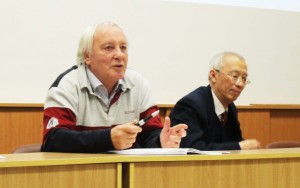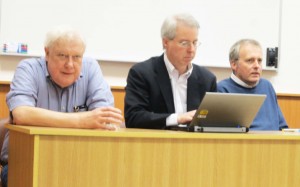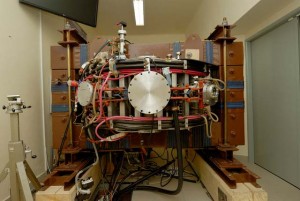
Lyn Evans (CERN, chair) and PAC member Jai-er Chen (Beijing University) at the review closeout. Image: GDE
The culmination of the work of the ILC Global Design Effort is to produce a Technical Design Report (TDR), which will be comprehensive and can be used as the basis of project proposals to collaborating governments. We are finalising the design that will be documented in the TDR as well as planning the pre-TDR R&D to be completed in 2012. An external assessment of our technical status and plans at this time can be particularly valuable in making changes for the TDR. We had just such an assessment in November 2011 when the Project Advisory Committee for the ILC met in Prague. Their review report provides both validations of the technical status and plans for the TDR, as well as some very useful guidance for the future.

PAC members Robert Orr (University of Toronto), Stuart Henderson (Fermilab) and Hans Weise (DESY) at the closeout. Image: GDE
The main recommendations and conclusions of the report are quoted below:
- The PAC is pleased to learn of the additional emphasis on cavity field emission.
- The current cavity tuner status is far from optimum, and the PAC would like to see one tuner design developed sufficiently to demonstrate its reliability.
- The Committee is following with interest the developments on tumbling as a cavity conditioning method.
- The Committee is impressed with the enormous effort at KEK and Fermilab to produce cavity strings that can be fully tested with beam. The Committee requests that a program of work be established post-2012 to maximize the information obtained from these facilities, in particular the long-term behavior under realistic fully loaded conditions so that the final design of the ILC can proceed with maximum operational experience.
- The Committee strongly endorses the continuation of cavity development past 2012.
- The PAC is interested to learn further on the need (or not) to have cavity location sorting.
- ATF is congratulated on its recovery from the earthquake, and the Committee reiterates its opinion that ATF2 is a very valuable community resource.
- The Committee agrees that the PPP approach to costing is the correct method to use for the TDR, but does note that there may be some exceptions for items where there is only a single supplier.
- It should be noted that there is a cost to the host-lab coordination of multiple in-kind contribution of the same item.
- The PAC supports the General Issues Working Group’s current and proposed activities as presented to this PAC meeting.
Overall, we believe this review is supportive and validates our preparations for the TDR and main goals in the future. Of special interest are recommendations 4 and 5, which give endorsement to the major thrust of the programme being planned to follow the completion of the TDR. The committee endorses carrying out a detailed programme of systems tests with fully loaded beam, using the mentioned superconducting radiofrequency facilities. We believe that in addition to the TDR, results from these systems tests will give confidence proceed with a construction project. The continued cavity work will also be beneficial in enhancing the flexibility to go to higher energies.
While in Prague, I also was invited to give a special general lecture at the Czech Technical University and while there was given a tour of the GOLEM Tokamak. This tokamak – a device that confines plasma in a toroidal shape – has an exceptional history. It was constructed in 1960 in Moscow under the name TM-1 as one of the first tokamaks built and is now the oldest tokamak in operation in the world. It serves as part of the fusion science programme as a learning device in a field that is now building the very large international project ITER, a step towards eventually creating fusion energy. An interesting feature of the GOLEM setup is that it is used remotely as a teaching instrument through their website.



Recent Comments